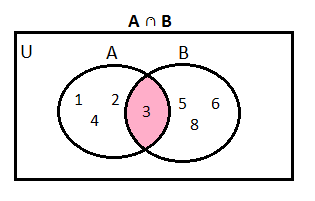Operations of Sets
Union of Sets
Intersection of Sets
Difference of Sets
Venn Diagram
 For
example, the given Venn diagram shows set A within the universal set U and A′
is the shaded
portion outside the circle known as complement of A.
For
example, the given Venn diagram shows set A within the universal set U and A′
is the shaded
portion outside the circle known as complement of A.Venn Diagram of Union of Sets
Venn Diagram of Intersection of Sets
Venn Diagram of Difference of Sets
Properties of Operations on Sets
Distributive Property
1. If A, B and C are three sets,
then A ∪ (B ∩ C) = (A ∪ B) ∩
(A ∪ C)
This property is called
distributive property over the intersection of two sets.
2.
If A, B and C are three sets, then the intersection is distributive over union
of two sets, i.e., A ∩ (B ∪
C) = (A ∩
B) ∪ (A ∩ C)
De Morgan’s Laws
If A and B
are two sets, then De Morgan’s laws state that:
1. (A ∪ B)′ = A′ ∩ B′
2. (A ∩
B)′
= A′ ∪ B′
To verify the above laws, let us consider an example.
If U = {1, 2, 3,
… , 20}, A = {5, 10, 15, 20} and B = {4, 8, 12, 16, 20}, then A ∩ B = {20}
(A ∩ B)′ = {1,
2, 3, 4, 5, 6, 7, 8, 9, 10, 11, 12, 13, 14, 15, 16, 17, 18, 19}
A′ = {1, 2, 3,
4, 6, 7, 8, 9, 11, 12, 13, 14, 16, 17, 18, 19}
B′ = {1, 2, 3,
5, 6, 7, 9, 10, 11, 13, 14, 15, 17, 18, 19}
A′ ∪ B′ = {1, 2, 3, 4, 5, 6,
7, 8, 9, 10, 11, 12, 13, 14, 15, 16, 17, 18, 19}
∴ (A ∩ B)′ = A′ ∪ B′
Now, A ∪ B = {4, 5, 8, 10, 12, 15, 16, 20}
(A ∪ B)′ = {1, 2, 3, 6, 7, 9,
11, 13, 14, 17, 18, 19}
A′ ∩ B′ = {1,
2, 3, 6, 7, 9, 11, 13, 14, 17, 18, 19}
∴ (A ∪ B)′ = A′ ∩ B′
Cardinal Properties of Sets
1. If A and B
are two sets, then n(A ∪ B) = n(A) + n(B)
– n(A ∩ B).
If A and B are
disjoint sets, then A ∩ B = φ. Hence, n(A ∩ B) = 0.
∴ For disjoint sets, n(A ∪ B) = n(A) + n(B).
2. n(A
– B) = n(A ∪ B) – n(B) = n(A)
– n(A ∩ B)
3. n(B
– A) = n(A ∪ B) – n(A) = n(B)
– n(A ∩ B)
4. n(A ∪ B) = n(A – B) + n(B – A) + n(A ∩ B)
5. If
universal set (U) is finite and A is any set, then n(A) + n(A′) =
n(U)
Example 1: If n(A) = 40, n(B) = 27 and n(A ∩
B) = 15, find
a. n(A ∪ B)
b. n(B
– A)
c. n(only
B)
Solution:
a. We know
that, n(A ∪ B) = n(A) + n(B) – n(A ∩ B)
∴ n(A ∪ B) = 40 + 27 – 15 ⇒ n(A ∪ B) = 52
b. n(B
– A) = n(A ∪ B) – n(A) = 52 – 40
= 12
c. n(only
B) = n(B – A) = 12
Example 2: If n(A – B) = 12, n(B – A) = 16 and n(A
∩ B) = 5, find
a. n(A)
b. n(B)
c. n(A ∪ B)
Solution:
a. We know
that, n(A – B) = n(A) – n(A ∩ B)
∴ 12 = n(A) – 5 ⇒ n(A) =
17
b. We know
that, n(B – A) = n(B) – n(A ∩ B)
∴ 16 = n(B) – 5 ⇒ n(B) =
21
c. Again, n(B
– A) = n(A ∪ B) – n(A)
∴ 16 = n(A
∪ B) – 17 ⇒ n(A ∪ B) = 33




